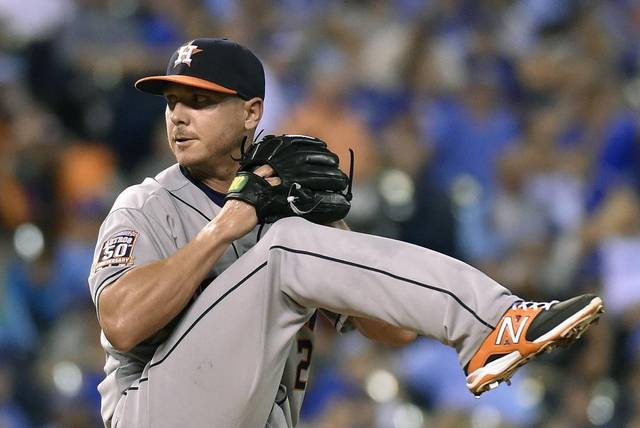Hidden in the aftermath of Wednesday’s announcement that the Dodgers have signed veteran free agent left-hander Scott Kazmir to three-year / $48 million contract is the fact that the Dodgers could very well have an Opening Day starting rotation comprised of five left-handers – Clayton Kershaw, Kazmir, Hyun-jin Ryu, Brett Anderson and Alex Wood. And while having five lefty starters (plus Julio Urias lying in wait) isn’t necessarily a bad thing, it probably isn’t the Opening Day pitching plan that Dodgers president of baseball operations Andrew Friedman and general manager Farhan Zaidi had in mind when the off-season began.

You need a math degree to figure out Scott Kazmir’s contract with the Dodgers.
(Photo credit – John Sleezer)
According to various reports, the Kazmir deal is loaded with surprises. First and foremost is that it apparently has an opt-out clause after only one year. What this means is that if the 32-year-old Houston, Texas native has a great 2016 season, it’s going to cost the Dodgers a boatload of money to keep him; whereas if he… well… sucks or (Heaven forbid) gets injured, the Dodgers are stuck with him for two additional years.
But wait, there’s more!
Apparently Kazmir’s three-year deal is also deferred for six years and includes a $5 million signing bonus on top of the $3 million that he will earn in 2016. Needless to say, Kazmir’s contract (and its $16 million Average Annual Value) gives a whole new meaning to the word “analytics.”
All of this being said, the Kazmir signing could have significant implications when pitchers and catchers report for spring training on February 19, 2016. It could very well improve the chances of 23-year-old right-hander Jose De Leon, the Dodgers top-ranked right-handed pitching prospect, and soon-to-be 24-year-old right-hander Jharel Cotton, ranked eighth, breaking big league camp on the team’s 25-man roster.

Top right-handed pitching prospect Jose De Leon knows exactly what he must do to make the Dodgers Opening Day roster – and he’s already working very hard at it. (Photo courtesy of @J_DeLeon18)
Now granted, it would take an absolutely phenomenal spring for De Leon and/or Cotton to make the Opening Day starting rotation – at least to begin the season – but doing so would break up the likely all-lefty starting rotation. And even if the Dodgers choose to keep De Leon and Cotton in the minors a bit longer, they also have right-handers Mike Bolsinger, Joe Wieland and Ross Stripling to draw from.
There is one thing that you can absolutely count on, however. The chances that Friedman and Zaidi are finished wheeling and dealing between now and Opening Day falls somewhere between slim and none – and slim just left town.




 December 31st, 2015 at 6:00 am
December 31st, 2015 at 6:00 am  by Ron Cervenka
by Ron Cervenka  Posted in
Posted in 

I have always detested deferring money. It was done in the days when apparently there was not enough money available although with wise management, there was sufficient funds to field a very competitive team ,at least in my opinion.
To me this deferred money has a different purpose as it would be hard to argue the Dodgers couldn’t come up with $18 or so over the next three years. My guess is that deferring the money makes Kazmir tradeable and I also guess that he won’t be a Dodger for three years. He will be 32 in January.
If he opts out he will not be signed by the Dodgers at age 33 for a boatload of money but more importantly not for a lengthy contract. Opting out would provide the the Dodgers with a draft pick, if I understand it correctly, as is with Greinke opting out. It looks like F&Z have covered some of the contractual analytical bases. I don’t think that contract and its various scenarios only favors Kazmir.
Having said that, let’s hope Scott Kazmir has another career year in 2016 regardless of how the contract plays out.
It also probably means one of the Dodgers lefties gets traded before ST. Perhaps Alex Wood is the most tradeable.
Jake Odorizzi and Carlos Carrasco are right-handers. Dare to dream – so are Chris Archer, Corey Kluber and Sonny Gray.
Your disdain for deferred money has been well documented, Harold, but in this case I believe that it absolutely had to be done in order to land Kazmir.
There is zero doubt that Kazmir was looking for a contract much longer than only three years – most likely five or six years – and the only way that he would agree to a shorter contract was to be guaranteed money well beyond his three-year deal with the Dodgers, which is exactly what he got.
When you look at the AAV of the deal for three years, Kazmir’s deal is worth $16 million per year, which is (about) what he is worth and pretty much in line with the current market for a top-of-the-rotation guy. As such, this favors the player. But when you look at the AAV over six years, the AAV is only $8 million per year, which favors the Dodgers. Although six years is a long time for a pitcher, chances are the going rate for a decent starter in 2021 will be considerably more than $8 million per season. Because of this, I see the opt-out clause as the deal maker here and further confirmation that this trend will only continue.
As noted in the article, if Kaz has a great season in 2016 and chooses to opt out, his AAV over the subsequent five years will skyrocket and, more importantly, the Dodgers will not be on the hook for it – unless they choose to re-sign him which, I believe, is highly unlikely with De Leon, Urias, Cotton, Holmes and several others nearly MLB-ready. This, in my opinion, makes the Kazmir opt-out clause far more palatable.
I believe in my comment I differentiated this deferred money from the McCourt practice. This deferred money has a “different purpose.”
I believe it does have a different purpose.Perhaps it had to be to satisfy Scott but I think that F&Z have a use for it too. I think it will make him more tradeable and I do think he will be traded before his three years is up if he doesn’t opt put.
I also think F&Z like the opt out as the farm system will soon put pitchers on the MLB roster. If chosen the opt out gives them a draft pick as with Zack.
I don’t see this contract as a one sided player wins all contract. I think F&Z can see a number of options for them in it.
I think the signing also signals a trade for a right-handed starting picture before ST.
They don’t need to trade for a right-hander. (Hint: Kenta Maeda).

Right-handed pitcher, that is. I would be just as satisfied to trade for a good one still under control.
Not sure if they want to put out up to $100 for Maeda. Really great stats with Hiroshima but not sure how they translate to MLB. That is, is he #2, #3, #4?
Is it safe to say that the opt-out makes it more like a one year contract?
It is for Kazmir as he can opt out after the 2016 season if he so chooses. The Dodgers are committed to three years if he doesn’t opt out.
Actually, they’re committed for six years if he doesn’t opt out.
Yah. That’s right. Deferred money over three years but is not his playing contract for three years?